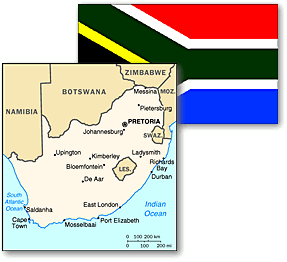Snapshot of South Africa
Location:
South Africa is located on the southern tip of Africa. Namibia,
Botswana, Zimbabwe,
Swaziland, and Mozambique all border South Africa to the north. Lesotho
is a country which
is landlocked inside South Africa.
Land Area:
South Africa covers approximately 1.2 million square miles.
Terrain:
The landscape of South Africa displays significant variation. There
are plateaus,
savannas, deserts, mountains, and coastal plains.
Climate:
The weather in South Africa is quite pleasant. The climate is similar
to that of
southern California.
Population:
There are 38 million people living in South Africa. Three-quarters of
South Africans
are black, and 14% are white.
Language:
South Africa has ten official languages: Afrikaans, English, Ndebele,
Pedi, Sotho,
Swazi, Tsonga, Tswana, Venda, Xhsa, and Zulu.
Religion:
Most South Africans are Christian. Other religions include: Hindu,
Muslim, Jewish, and
traditional African faiths.
Major Cities:
South Africa has three branches of government and a capital city for
each. The
administrative capital of South Africa is Pretoria, the legislative
capital is Cape Town,
and the judicial capital is Bloemfontein. Other large cities in South
Africa are Durban,
Johannesburg, and Port Elizabeth.
Government:
The Union of South Africa was formed in 1910, and in 1934 South Africa
became a
sovereign
state within British empire. In 1948, the National Party took control
of government and
began enforcing a system of racial segregation called "apartheid"
(separateness). The system of governance strictly limited the political,
economic, and
social rights of the black South African majority. The African Nation
Congress (ANC) is a
political movement that was formed to counter the apartheid government.
Nelson Mandela and
many other leaders of the anti-apartheid movement were imprisoned. In
1991, the Group
Areas Act, Land Acts, and the Population Registration Act abolished the
pillars of
apartheid. Mandela was released from prison and a nonracial, democratic
constitution came
into effect on April 27, 1994. Two weeks later, Mandela, the winner of
South Africa’s
first nonracial election, was installed as president. President Mandela
signed a new
constitution into law on December 10, 1996, and it entered into
force on February 3, 1997.
Economy:
The economy of South Africa is highly industrialized, but displays
great inequalities
of wealth and income resulting from earlier apartheid policies. South
Africa has rich
mineral resources. It is the largest producer and exporter of gold in the
world. South
Africa is a net exporter of agricultural products. Important crops
include: citrus and
deciduous fruits, corn, wheat, dairy products, sugarcane, tobacco, wine,
and wool. South
Africa also boasts highly developed manufacturing, and is a world leader
in the production
of synthetic fuels and mining equipment. A modern telecommunications and
transportation
infrastructure aids the South African economy.

![]()


![[White House icon]](/New/images/home_pin.gif)
![[Help Desk icon]](/New/images/help_pin.gif)